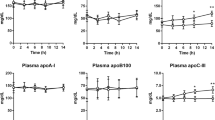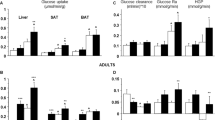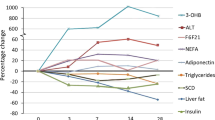Abstract
OBJECTIVE: To test the hypothesis that the hepatic secretion of very-low-density lipoprotein (VLDL) apolipoprotein B-100 (apoB) is increased in men with visceral obesity and to examine whether the oversecretion of this apolipoprotein is related to insulin resistance and increased hepatic availability of lipid substrates.
SUBJECTS: 16 obese men (body mass index (BMI)>30 kg/m2, waist circumference >100 cm) and 16 non-obese, age matched men, were studied.
MEASUREMENTS: The hepatic secretion of VLDL apoB was measured using a primed (1 mg/kg), constant (1 mg/kg/h), intravenous infusion of 1-[13C]-leucine. Isotopic enrichment of VLDL apoB was determined using gas-chromatography mass spectrometry and a multi-compartmental model (SAAM-II) was used to estimate the fractional turnover rate of VLDL apoB.
RESULTS: Plasma concentrations of total cholesterol, triglyceride, glucose, insulin, mevalonic acid and lathosterol, as well as dietary fat intake, were significantly higher (P<0.05) in obese than control subjects. The obese subjects had significantly lower high-density-lipoprotein cholesterol (P<0.01). VLDL apoB pool size and hepatic secretion rate (mg/kg fat free mass/d) were significantly higher in the obese than non-obese subjects (P<0.02). The fractional catabolic rate of VLDL apoB was lower in the obese subjects compared with controls, but the difference did not attain conventional significance (P=0.053). In pooled analysis, there was a significant positive association (P<0.05) between VLDL apoB secretion rate (mg/kg fat free mass/d) and waist-to-hip ratio (WHR), waist circumference, and fasting plasma triglyceride, insulin and glucose concentrations. In multiple linear regression analysis, the association between VLDL apoB secretion and fasting insulin concentration was independent of age, apolipoprotein E (apoE) genotype, mevalonic acid concentration, free fatty acid concentration and fat intake.
CONCLUSION: Our findings are consistent with the hypothesis that in visceral obesity, insulin resistance and the associated increased lipid substrate supply to the liver contribute to hepatic oversecretion of apoB; expansion in the VLDL apoB pool size may also be due to a catabolic defect related to insulin resistance.
This is a preview of subscription content, access via your institution
Access options
Subscribe to this journal
Receive 12 print issues and online access
$259.00 per year
only $21.58 per issue
Buy this article
- Purchase on Springer Link
- Instant access to full article PDF
Prices may be subject to local taxes which are calculated during checkout
Similar content being viewed by others
Author information
Authors and Affiliations
Rights and permissions
About this article
Cite this article
Riches, F., Watts, G., Naoumova, R. et al. Hepatic secretion of very-low-density lipoprotein apolipoprotein B-100 studied with a stable isotope technique in men with visceral obesity. Int J Obes 22, 414–423 (1998). https://doi.org/10.1038/sj.ijo.0800602
Received:
Revised:
Accepted:
Published:
Issue Date:
DOI: https://doi.org/10.1038/sj.ijo.0800602
Keywords
This article is cited by
-
The impact of phospholipid transfer protein (PLTP) on lipoprotein metabolism
Nutrition & Metabolism (2012)
-
Clinical dyslipidaemia is associated with changes in the lipid composition and inflammatory properties of apolipoprotein-B-containing lipoproteins from women with type 2 diabetes
Diabetologia (2012)
-
Grape seed proanthocyanidins correct dyslipidemia associated with a high-fat diet in rats and repress genes controlling lipogenesis and VLDL assembling in liver
International Journal of Obesity (2009)
-
Fatty liver, insulin resistance, and dyslipidemia
Current Diabetes Reports (2008)
-
Relationships in women between body mass index and the intravascular metabolism of chylomicron-like emulsions
International Journal of Obesity (2004)



